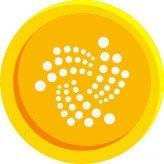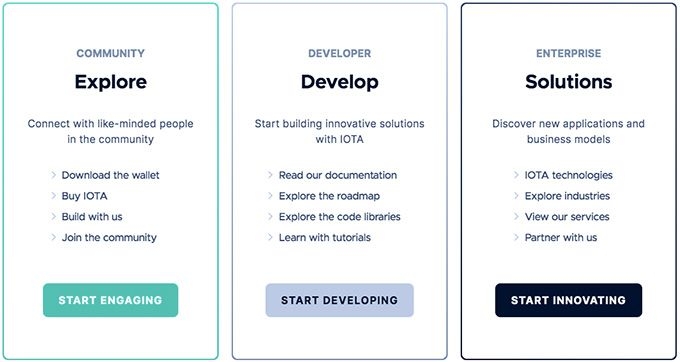
Stop overpaying - start transferring money with Ogvio. Sign up, invite friends & grab Rewards now! 🎁
So, you’re interested in the relatively new and exciting cryptocurrency — the IOTA coin. That said, you have no idea what it is or how it works? Well, don’t worry, we have you covered on the IOTA coin question.
Spoiler alert: did you know that IOTA doesn’t actually have a blockchain?
Anyway, in this “what is IOTA coin?” guide, I will start by explaining the very basics of the project, as well as how the technology works. I will explain everything in the simplest way possible, using real-world examples.
After that, I will then talk about IOTA’s current stage of development and how secure (or not secure) their protocol is.
So, by the end of reading this guide, you will no longer be asking "what is IOTA?". In fact, you’ll almost be an expert on the topic. If you were to become interested in getting yourself some IOTA coins, too, do make sure to consult a financial advisor before doing so, and that you only use trusted exchanges, such as Binance. Also, always keep your cryptocurrencies in secure wallets, such as Ledger Nano X and Trezor Model T.
Looking for the most secure place to buy BTC? I have collected the best-rated crypto exchanges that were approved as the safest platforms for buying BTC below, so take a look.
Pros
- Minimal transaction fees
- Extremely scalable
- Unique Proof of Wok protocol
Cons
- Some security concerns
- Technical flaws
Table of Contents
The Basics of the IOTA Coin

The IOTA project was originally created in late 2015 by Sergey Ivancheglo, David Sontesbo, Serguei Popov and Dominik Schiener. Since IOTA was launched, it has been managed by the IOTA foundation, which is located in Germany.
Like many other cryptocurrency projects, IOTA wanted to create a payment system that could process faster, more secure, cheaper, and more scalable transactions.
IOTA does not want to not limit itself to just financial transactions, though, but also to allow the movement of any data from one machine to another.
The IOTA project also has its own cryptocurrency, too, which is called MIOTA. However, to keep things simple, I will refer to it as the IOTA coin!
Before IOTA officially launched, it raised funds through an initial coin offering (ICO). In total, the project received more than 3000 Bitcoin, which at the time was worth $434,000. Since then, the market capitalization of IOTA has reached heights of more than $14 billion!

What this means is that all the pieces of data are linked together — take a look at the screenshot below. 
The next part of my “What is IOTA” guide is going to look at how transactions are confirmed!
IOTA Mining – How Does the Network Confirm Transactions?
Another interesting thing about Tangle is that it doesn’t use miners.
For example, when transactions are confirmed in Bitcoin, people who volunteer their extra computing power are rewarded with extra Bitcoin for using their resources. These miners are not actually involved in the transaction itself. Instead, they are confirming other people’s transactions.
This particular consensus mechanism is called Proof-of-Work (PoW). The issue when using the only PoW is that it gets more and more expensive to confirm a transaction as time goes by. This is because the difficulty of mining becomes harder, meaning that more computing power and electricity is required.
This has also resulted in slow and expensive transactions. Most importantly, it means that the Bitcoin blockchain is only able to confirm a maximum of 7 transactions per second.
In the IOTA network, things work differently, as anybody who wants to use the system to send funds must also contribute to the network by confirming other people’s transactions. Here is an example of how it works:
- John sends funds to Charlie.
- During the transfer, John also needs to confirm the transactions for two other people – Billy and Kate.
- He does this by contributing his computing power.
- Next time Billy or Kate wants to send someone money, they must do the same thing by confirming the transactions of two other people.
The idea behind this is that as more and more people use the IOTA system, the network becomes more and more scalable. This means that in reality, there is no limit to the number of transactions the network can process each second, meaning that it is “infinitely scalable”.

Interestingly, the IOTA team state that this small contribution is still a type of PoW, however, it is a much more efficient system!
So, now that you know how transactions are confirmed, the next part of this IOTA coin guide is going to look at transaction fees.

Did you know?
All Crypto Exchanges may look similar to you but they're NOT all the same!
IOTA Coin Transaction Fees
A further advantage of Tangle is that, because there is no IOTA mining, transactions are basically free. This is because everybody contributes to the network by confirming other transactions, meaning that the only cost is the small amount of extra electricity required. This is very appealing to a lot of people and makes IOTA coin an ideal payment system.
By removing the need to pay transaction fees, the IOTA coin protocol can also be used to process micropayments. A micropayment is within the name — a really small amount of money.
An example of an industry that would benefit from using IOTA for micropayments is affiliate link providers. This is when somebody advertises a company on their website and when the user clicks it, the website makes a small amount of money as commission.
However, traditional payment systems are unable to do this as they charge such high transaction fees. Blockchains such as Bitcoin cannot handle micropayments are their fees are way too high. In fact, in late December 2017, Bitcoin fees reached up to $40 per transaction!
IOTA Coin Transaction Speed
As IOTA is still in its early days, there is no official transaction time yet. There are various factors that determine how quickly funds arrive in your wallet, which I will explain below.
Firstly, as everyone who wants to send funds must confirm two previous transactions, they need to perform a very quick PoW action. How long this takes will depend on how fast the user’s computer is. The faster it is able to solve the PoW puzzle, the faster it can verify someone’s transaction.
Secondly, I mentioned earlier that as more and more people use the IOTA coin network, it can process more and more transactions. However, as IOTA is still a new project, not many people are using it yet.
We've been running stresstests all week long. It's starting to look really good, with a public release coming soon. 1000 TPS next. #IOTA pic.twitter.com/Nk0H3v410T
— Dominik Schiener (@DomSchiener) April 29, 2017
To make sure the network is operational, the IOTA team has installed something called a “coordinator”. This is like a centralized protocol that performs the same task as individual users. When IOTA becomes more mainstream and attracts more users, it will no longer need a coordinator.
So, in its current stage of development, transactions could take a couple of minutes, or if the network is not performing well, it could take much longer. Ultimately, for the IOTA coin network to perform at its full potential, it needs lots of people to use it.
The team is working on a protocol called “Flash Channels”, which it claims will have the ability to confirm transactions instantly. If they are able to achieve this, it could become a faster cryptocurrency in the world!
Is IOTA Safe and Secure?
So, the IOTA coin project has some big ambitions, however, it is really important to understand that they are still in the development stage. In fact, the network has already experienced quite a few technical issues, which I will discuss below.
The coordinator protocol that I mentioned earlier is centralized, which means that if it stopped working properly, then the entire network could be at risk. This has already happened multiple times, and at one point the IOTA system was unusable for days.
The centralized coordinator has also been installed to protect the network from a 34% attack. This is when somebody gains so much computing power on the network that they are able to make changes to it.
In the end, at least $3.94m worth of IOTA was stolen. This was facilitated by a DDoS attack against all public nodes.
— nic carter (@nic__carter) January 21, 2018
Bitcoin is also at risk of a similar attack; however, the hackers would need to get 51% of the total hashing power. This is virtually impossible now because the Bitcoin blockchain has so many miners.
However, in the case of IOTA, if the coordinator goes down, then the network is at great risk. Although IOTA aims to be completely decentralized, it won’t be able to achieve this until it is able to function without the centralized coordinator.
There are also concerns that the IOTA coin system could be at risk of a replay attack. A replay attack is when hackers are able to repeat a transaction without the sender knowing. If successful, they can steal coins from someone’s personal wallet.

More bad news for the IOTA project — in late 2017, researchers at the Massachusetts Institute of Technology (MIT) released an academic paper that claimed the IOTA network had lots of security flaws. MIT is one of the best universities in the world and any research they perform is highly respected.
All of the above issues indicate that the IOTA coin project is far from a finished product. In fact, there is no official date that indicates when it will be, so it is best to keep checking their development blog, which you can access by clicking this link.
It's crucial to mention that if you take your security seriously, you should buy IOTA from reliable crypto exchanges, Binance is one of the recommended options. Also, store your assets in hack-proof wallets, such as Ledger Nano X and Trezor Model T.
So, now that you know where the IOTA coin team is with their progress, I will now talk about how the IOTA coin can be used and abused.
How IOTA Can be Used & Abused
If IOTA is able to meet all of their targets, then there are some really good real-world uses that it could be applied to. Firstly, if the platform is able to process instant, free and unlimited transactions, it would be ideal as a global payment system.
Both Individuals and organizations could send funds to and from anywhere in the world at the press of a button. I also mentioned earlier that because transactions are free, it is also perfect for the micro-payments industry.
It is also hoped that IOTA will be able to process more than just financial transactions, in what the team calls the “Machine-to-Machine Economy”. One example of this is the electric vehicle charging industry.

IOTA recently announced that it has built a car charging facility in the Netherlands that will allow people to pay for the electricity they use, automatically. The electric car will be fitted with an automatic meter that will automatically calculate how much electricity was used, and then take the payment.
This could be applied to absolutely anything that needs to transfer data from one device to another.
Another real-world advantage for IOTA is that it is being designed to be resistant to a quantum attack. Quantum computing is a really advanced area of science that hasn’t actually been invented yet, but organizations such as NASA and the CIA are working on it.
The current technology that first and second-generation blockchains like Bitcoin and Ethereum use are based on cryptography, which at the moment is virtually impossible to hack. However, the theory is that once quantum computers are built, they will be able to override these blockchains easily.
To make sure that IOTA is fully protected against any quantum attacks of the future, it is designing a protocol that will be resistant to it!
Pros & Cons of IOTA
I know this "What is IOTA Coin" guide has already provided you with lots of information, but I will now summarize it all with some pros and cons!
 PROs
PROs
✓ Free transactions
✓ Unlimited scaling
✓ Can process any data, not just financial transactions
✓ Hopes to achieve instant transactions
✓ No IOTA mining – everyone contributes
Quantum resistant
 CONs
CONs
✗ No finished product yet
✗ Unclear when the project will be ready
✗ Currently needing to use a centralized coordinator
✗ Has experienced lots of technical flaws and bugs
✗ Many (including MIT) think it has really bad security

Did you know?
All Crypto Exchanges may look similar to you but they're NOT all the same!
Conclusion
In my opinion, IOTA has a lot of potentials to be used on a global scale. As long as the team can bring their goals to life, then I think the project will be a huge success.
Anyway, that draws the end of this What is IOTA coin guide! I know a lot of the information I’ve provided might seem really complicated, but I hope you have found my explanations easy enough to digest.
If you have read it from start to finish, you should have a good idea of what the IOTA coin project is and what they plan to do. You should also have a good understanding of how the technology works.
I also spoke about what the team has achieved so far and what they still need to work on. Hopefully, you understand that the idea of the project is fantastic, but until they have a finished product, it is just theoretical.
If you plan on buying some IOTA (or, rather, MIOTA) coins yourself, do make sure that you use a trusted exchange - Binance appears to be one of the user favorites! Also, don't forget to keep your assets in a secure cryptocurrency wallet - Ledger Nano X and Trezor Model T are among the most recommended options.
If you're a bit lost, here are a few easy steps o how to get and store IOTA coin:
1. Get a secure crypto wallet - Ledger or Trezor are highly recommended.
2. Sign up to Binance.
3. Purchase IOTA coins from Binance.
4. Send your IOTA coins to the wallet of your choice.
That's it! The process is truly simple.
The content published on this website is not aimed to give any kind of financial, investment, trading, or any other form of advice. BitDegree.org does not endorse or suggest you to buy, sell or hold any kind of cryptocurrency. Before making financial investment decisions, do consult your financial advisor.









